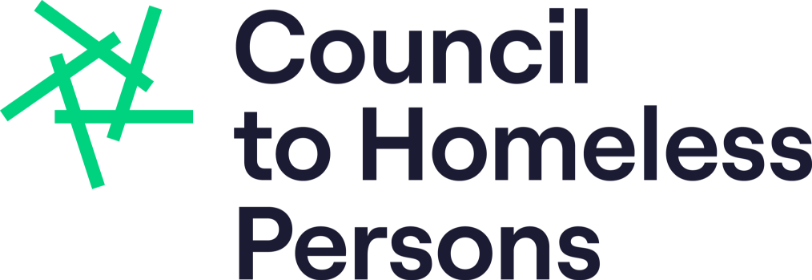by Peter Jones, Aboriginal Housing Victoria
This article was originally published in Parity magazine. Learn more about Parity magazine including how to access full editions.
Aboriginal Homelessness in Victoria
The roots of Aboriginal Homelessness in Victoria run very deep. I recently read James Boyce’s history, Van Diemen’s Land, and was reminded that many of the opportunists and fortune hunters responsible for the murderous ethnic land clearing of the Apple Isle between the late 1820s and 1833 were seminal in the establishment of the Port Phillip Colony (now Victoria) a few years later.
Perhaps predictably, the first two men executed in the new colony were Indigenous men from Tasmania, Tunnerminnerwait and Maulboyheenner. They stood in the way of the misappropriation process1, and thus began a pattern of criminalisation and punishment of Aboriginal people, to parallel their dispossession, that continues unbroken to the present day.
Six hundred and eighty-six (686) Aboriginal people leaving Victorian prisons in 2019–2020 required homelessness assistance. They now constitute eight per cent of demand for such support, up from just three per cent in 2011–12.
Given that their lands were stolen and they were excluded from the economy for over a century, denied citizenship rights and removed from their families, we shouldn’t be entirely surprised that Aboriginal Victorians continue to experience elevated rates of homelessness.
But things are getting better right? Well, yes and no. I want to use this article to take you through some of the more granular information about the contemporary crisis in housing that First Peoples face in Victoria circa 2021.
Mana-na woorn-tyeen maartakoort: Every Aboriginal Person Has a Home
Victoria is engaged in new way of doing business in Aboriginal Housing and Homelessness. In 2020, in the Victorian Parliament, the Victorian Government adopted an Aboriginal Housing and Homelessness policy (Mana-na woorn-tyeen maartakoort). Nothing unusual about this, except that the policy adopted by the State was developed by Victoria’s Aboriginal community.
In the time since its launch governance arrangements have been established to implement the policy. The Implementation Working Group is jointly chaired by the CEO of the largest Aboriginal controlled housing organisation in Victoria, Darren Smith, and the CEO of the Victorian Government’s own housing agency, Ben Rimmer. Its members include senior Victorian Aboriginal community leaders and senior government officials, working together on equal terms.
So this is a new kind of partnership, hinged by self-determination. Mana-na woorn-tyeen maar-takoort has delivered some important initial benefits. In November 2020, the Victorian Government announced the largest investment in social and affordable housing in the state’s history, $5.3 billion over four years. The Andrews Government has committed that 10 per cent of its Big Housing Build investment will be dedicated to housing Aboriginal families. Without the Aboriginal policy framework and the strong working relationship between the community and the Government this would have been improbable.
The Implementation Working Group has also secured a number of program investments that have begun to make a difference. One example is an Aboriginal‑specific Private Rental Assistance Program. The program is providing brokerage resources and support for Aboriginal people experiencing homelessness to move into the private rental market.
Complementing this program is work Aboriginal Housing Victoria is undertaking with the Residential Tenancies Commissioner to examine racial discrimination in the private rental market and recommend legislative, regulatory and programmatic changes to tackle it. Aboriginal Housing Victoria has also secured the largest one-off investment in social housing maintenance funding in a generation for 21 Aboriginal housing providers
across Victoria. Working in partnership with government, the Aboriginal community shaping policy and programs, is paying dividends.
Can the target of 10 per cent reduction in homelessness each year be met?
The scale of the challenge to address Aboriginal homelessness in Victoria is immense. An early commitment made to the Aboriginal community through Mana-na woorntyeen maar-takoort was that they would receive regular progress reports on the strategy’s implementation that would deal not simply in activity reporting, but in results.
To this end, in 2021, the Mana-na woorn-tyeen maar-takoort Implementation Working Group released its first Annual Report Card of progress in implementing the strategy. The Report Card will be released each year, updating 20 measures of housing outcomes to provide clear, accessible, quantitative evidence of how Aboriginal Victorians are faring relative to other Victorians and other Aboriginal Australians on these measures. Without accountability we can expect no improvement.
The 2021 Mana-na woorn-tyeen maar-takoort Annual Report Card makes for grim reading. Aboriginal housing outcomes in our state in the period immediately predating the Framework were appalling and unacceptable. But the merit of the Report Card is that it establishes a baseline from which to measure whether the actions being taken to reduce housing distress and homelessness are commensurate with the scale of the challenge. They will help answer the question: Will some of the largest investments in social housing we have seen end or reduce Aboriginal homelessness in Victoria?
In particular, will the target, established in Mana-na woorn-tyeen maar-takoort, to reduce Aboriginal homelessness by 10 per cent per annum for 10 years, be achievable on the basis of existing commitments, effort and investment? To answer this question requires some analysis of the 2021 Report Card findings and what they tell us about the scale, pattern, trends and drivers of the contemporary housing crisis visited on Aboriginal people in Victoria.
It is a nonsense to rely on census data to measure homelessness. The census
undercounts Aboriginal people and it undercounts the homeless. The Report Card relies on Australian Institute of Health and Welfare (AIHW) data on the rate and number of people who present each year to specialist homelessness services already homeless. To grasp the scale of the challenge to reduce this by 10 per cent each year we must understand: whether the rate has been growing or falling; how many of the homeless people presenting for housing assistance are able to be housed; and what is causing their homelessness.
The grey line on the table below is the rate of Victorian Aboriginal people presenting to homeless services each year from 2011–12 to 2019–20. The rate has grown from fewer than 10 per cent of the population to almost 17 per cent in less than 10 years. Both the rate and speed of growth in demand for homelessness services are the highest in Australia. Almost half of these Aboriginal people in Victoria are homeless on presentation. This means that, at a minimum, eight per cent of Victoria’s Aboriginal population has experienced homelessness in each of the past two-years and a further nine per cent are on the cusp of homelessness.
So if we are to reduce the rate of homelessness, this trend will need to be reversed. That depends, among other actions, on resolution of the crisis of these people once they enter the homelessness system. But we now know that two in three Aboriginal people who enter this system homeless are still homeless when their period of support ends.

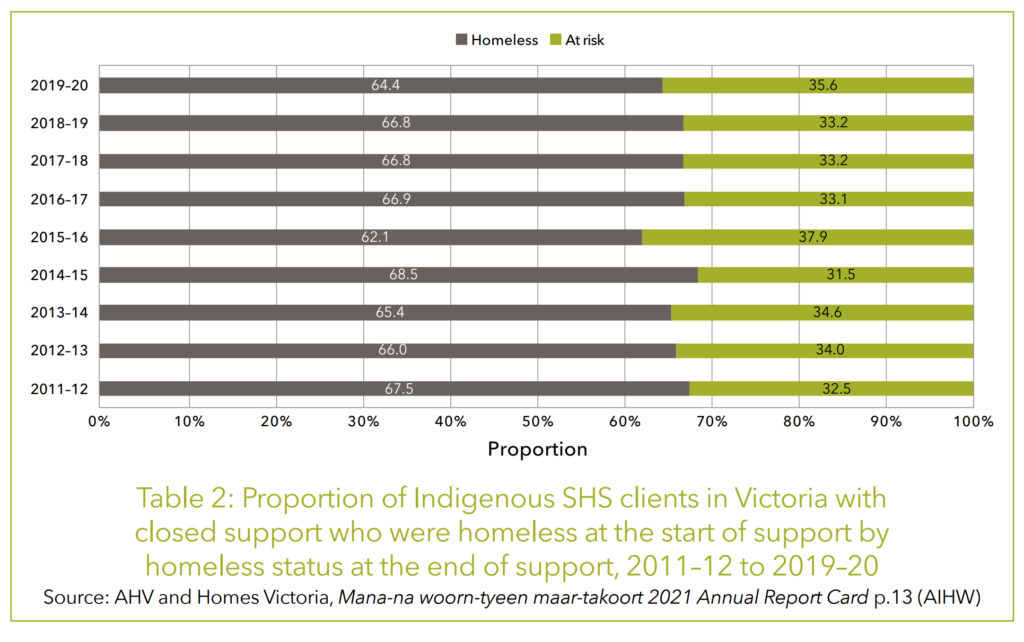
As Table 2 shows, this has been the case for the past decade and shows no sign of shifting. Aboriginal Housing Victoria has recently commissioned work to better understand the shortcomings of the specialist homelessness service system and how these may be rectified. The results are not yet available but will inform future policy. Some things we already know. If homeless people were having their issues resolved they would not return to the homelessness system. But in Victoria, Aboriginal people return repeatedly for crisis assistance, as Table 3 demonstrates. By 2019–20, three in four Aboriginal Victorians seeking crisis assistance from homelessness services had sought assistance before. The proportion of returning Aboriginal clients grows year on year and is higher
than elsewhere in Australia.
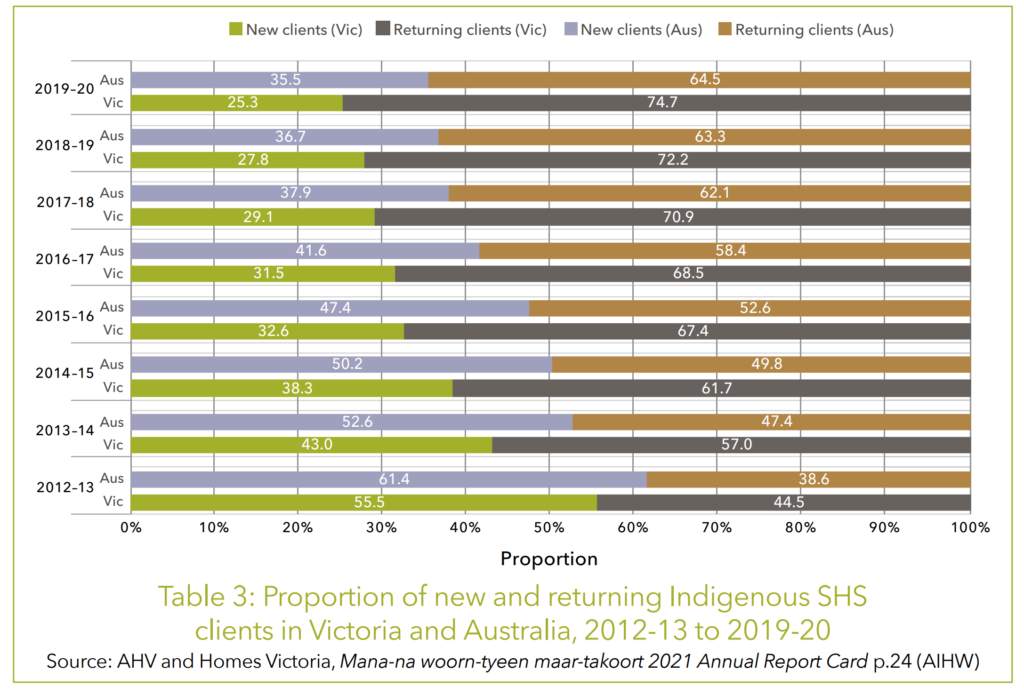
The number of Aboriginal people whose housing needs have been met over the past decade may help explain this revolving door effect. Table 4 shows that, from an already low rate, our capacity to meet housing needs of Aboriginal people experiencing homelessness has fallen off a cliff in Victoria over the past ten years. It means that three in four of those assessed as having a long-term housing need (the purple bars in Table 4) are now unable to be assisted (coincidentally the same proportion as are returning for help each year).
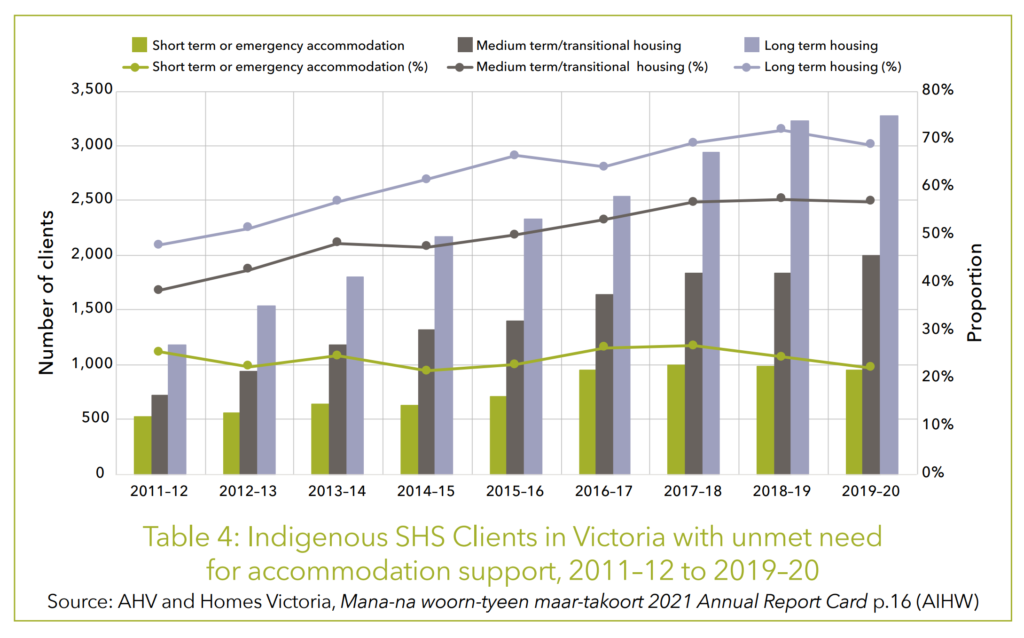
This rate of unmet need is up from fewer than 30 per cent of those in need who were turned away a decade ago. If we discount referrals, only six per cent of those with long-term housing needs are directly assisted.
All of which suggests that the Victorian Government is on the right track in making the largest investment in social and affordable housing in our state’s history. It is forecast to deliver 820 social housing units to Aboriginal Victorians over four years (10 per cent of 8,200 or around 205 units a year). Which begs the question: Is the investment sufficient to turn the rates of homelessness around?
The best immediate indicator is the number of Aboriginal families on the housing register waiting list in our state. In June 2019 there were 4,324 such households, around one third of whom were “homeless with support” according to the housing registrar. A year later in June 2020 there were 4,879 — an increase of 555 in a year (see Table 5).
| 2019 | 2020 | |
|---|---|---|
| Indigenous | 9.05% (4,324) | 10.21% (4,879) |
| Non-Indigenous | 0.84% (50,145) | 0.90% (53,120) |
Source: Aboriginal Housing Victoria and Homes Victoria, Mana-na woorntyeen maar-takoort 2021 Annual Report Card p.26
If this rate of demand were to continue, we would require an additional 555 social housing units a year (a shortfall of 350 relative to current commitments) simply for rates of Aboriginal housing distress and homelessness not to deteriorate further.
The Victorian State Government has demonstrated a significant amount of good faith in attempting to reign in galloping rates of Aboriginal homelessness in our state. In a genuine act of self‑determination, it has devolved policy leadership to Victoria’s Aboriginal leadership; its senior housing officials have worked professionally and collegiately with the Aboriginal community to address programmatic challenges and review regulatory settings with a view to lifting cultural safety; and it has begun to invest in capital growth in social housing for the first time in decades.
But to act effectively requires us to understand the facts. The truth revealed in the data contained in the 2021 Mana-na woorn-tyeen maar-takoort Report Card is that current commitments cannot be expected to reduce rates of Aboriginal homelessness in our state. The question then arises: Is it acceptable for the people with the greatest hereditary rights to live in our state to continue to experience homelessness at a rate 10 or 11 times that of their fellow Victorians?
The Mana-na woorn-tyeen maartakoort strategy is not seeking charity. It is invoking social justice to seek housing parity for First Australians. The reality is that in Victoria we are only at the very beginning of a 20-year plan to turn around a homeless crisis visited on our Aboriginal citizens that was almost 200 years in the making. Now is the time to dig in and fight. There will be many calls on the Government’s resources as our community emerges from the pandemic lockdown. None of them can be louder than the demand to honour the right of every First Nations person in our state to have a home in their own land.
Aboriginal Housing is Every Government’s Business
Providing more affordable and social housing is important, but that is not a state responsibility alone and, by itself, will not resolve the homelessness crisis. State Governments with all the will in the world cannot create housing security if Commonwealth Government policy settings undermine it. The three per cent of the housing economy that is social housing cannot, by itself, compensate for the 97 per cent that is not, in arresting runaway homelessness. Just to build that three per cent to four per cent will require a significant additional investment beyond that committed.
At an AHURI conference in Sydney in 2019, AHV argued that the Australian housing market was characterised by:
housing that was unaffordable for people on average incomes to buy
a rental housing market in which it was unaffordable for people on lower incomes to rent
a marginal social housing offering that continued to shrink relative to population.
Despite the significant changes wrought by COVID-19, there is little evidence to change this assessment.
CoreLogic’s research director, Tim Lawless, says “housing prices have risen almost 11 times faster than wages over the past year“. It now takes around 11 or 12 years for a worker on the median full-time salary (about $80,000) to save a 20 per cent deposit on the median Victorian home ($688,000), assuming a savings rate of 15 per cent of gross income. The challenge to buy in Melbourne is significantly greater, where the median price by March 2021 was $812,000.
Australia’s tax treatment of housing as primarily an asset investment class and only secondly a source of shelter, conspires with other policy factors, to make home ownership a continuously receding dream for people on average wages in Australia as speculative property investors prosper. Tax distortions actively disadvantaging owner-occupiers have led to a massive unbalancing of investment from productive business activity into static residential assets.

The OECD makes this point forcefully in its 2021 Survey of the Australian Economy (September 2021), expressing concern at Australian banks having the highest exposure to residential real estate debt in the OECD and households the second highest overall debt to GDP ratios (see Table 6).
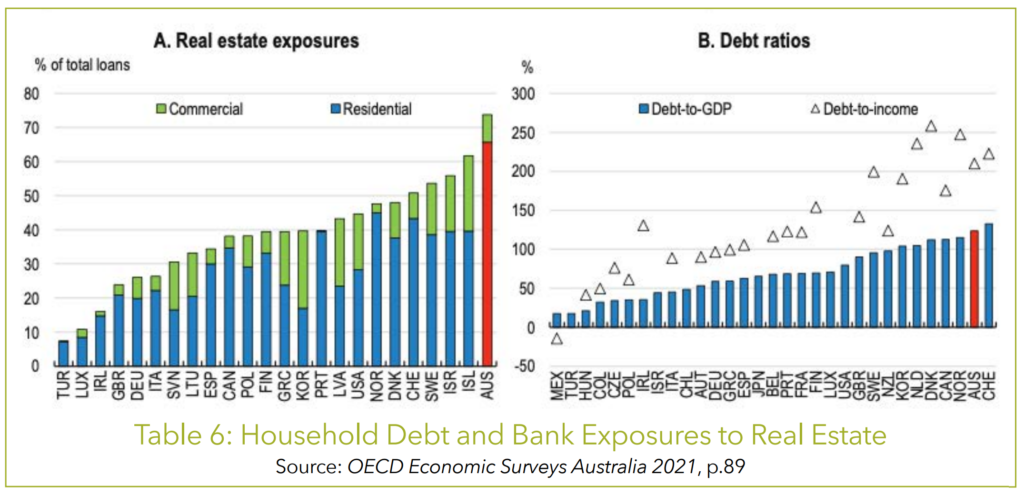
Those locked out of home ownership rely on a crowded private rental market where competition is fierce. More and more Aboriginal Victorians find themselves in this market. By 2016, 27 per cent of Aboriginal Victorians were living in the private rental market (up from 21 per cent a decade earlier). The AIHW has shown that, by 2016, 41 per cent of renting Aboriginal households living in Victoria were in housing stress, up from around 22 per cent in 2001 and we can be confident things have not improved since then.

Low incomes and racial discrimination place Aboriginal households at the end of a very long queue for scarce private rental offerings. In much of regional Victoria the private rental market is saturated, with virtually no new rental lettings available, as many citizens escape city lockdowns and take the opportunity to work remotely. To underscore the sweep of demand, the Victorian Valuer-General has shown that the number of country Victoria house sales for the first quarter of 2021 was 39.6 per cent higher than for the first quarter of 2020. Because half of Victoria’s Aboriginal people live in rural and regional Victoria they are disproportionately displaced by this latest piece of housing market failure.
The lowest rates of income support for unemployed people in the OECD have seen the rental purchasing power of Newstart erode year on year for the past decade and longer. After a brief holiday from poverty, Newstart rates were reset to breadline levels unrivalled in the OECD in early 2021.
Experiencing double the mainstream rate of unemployment 14 increases Aboriginal exposure to pitiful levels of income support. Again the OECD’s most recent economic survey of Australia provides explicit advice to the Australian Government to target greater income support to Indigenous Australians, who need it most.
A strong emphasis on targeted welfare policies for specific groups experiencing complex disadvantage and particularly high poverty rates is needed. The plight of Indigenous Australians persists, with the gap between Indigenous and non‑Indigenous employment rate around -20 percentage points in urban regions and -35 percentage points in rural areas.
OECD Economic Surveys Australia 2021, p. 37
Finally, as we have shown, demand continues to dwarf supply of social housing, which now constitutes around three per cent of all housing tenure in our state. The end game of cascading housing market failure (unaffordable house prices; a dangerously stressed private rental market; and a frayed social housing safety net) is homelessness on a vast scale for the most disadvantaged members of the community. As in the rest of Australia, that burden falls hardest on First Australians in Victoria, where a staggering one in six seek homeless support each year.
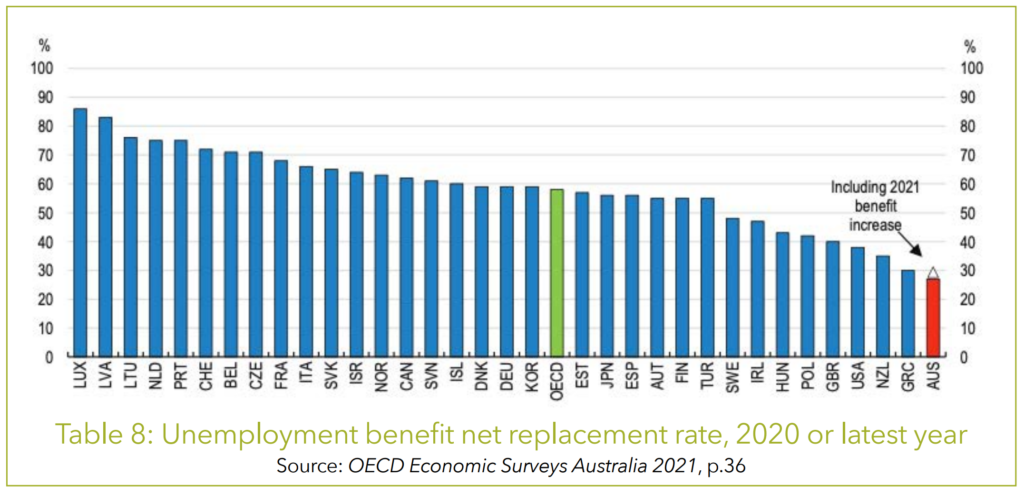
Where to from here?
Victoria is in the early stages of a policy experiment in which policy leadership for Aboriginal housing and homelessness is at least partly in the hands of the Aboriginal community. But wider economic policy settings, undermining housing affordability, present a formidable barrier to progress.
One of the early outcomes of this experiment is that we have never had clearer information about the scale of the housing challenge our community faces. Their lived experience left the Aboriginal community in no doubt they were experiencing a housing crisis but the data to enumerate it had been missing. We have now unequivocally demonstrated the scale of the challenge and the massive investment and policy shifts, including to the tax and transfer system, required to overcome it.
In recent decades, as the profound injustice of Australia’s history of colonisation has been brought increasingly into focus, there has been a familiar refrain from white Australians of goodwill asking: Why weren’t we told?
When it comes to Victoria’s contemporary crisis in First Australians’ homelessness, governments can no longer plead ignorance of the depths of the problem or the investment and policy change required to redress it. We may or may not choose to invest the necessary resources to solve this homelessness crisis. We may or may not reset the policy levers that privilege the interests of property fortune hunters over the homeless. But if we choose to shirk the challenge, let’s not let another decade pass only to pay Indigenous Victorians the disrespect of pretending we didn’t know our efforts at reform would be insufficient to close the abysmal housing gap Australian Government policies have created.
To read more articles like this, and to stay up-to-date with insights for and from the sector, become a Parity subscriber.
1 In a piece of jaw-dropping hypocrisy, the “Protector of Aborigines”, George Augustus Robinson, sealed the fate of the two men with his 1842 court testimony that, “they have a knowledge of the principles of religion and the existence of a Supreme Being and know right from wrong.” Robinson was handsomely rewarded for his role in the ethnic land clearances of Tasmania with a bonus land grant of 3,000 acres, the original owners having been successfully evicted, partly through his duplicity, to islands in Bass Strait.
